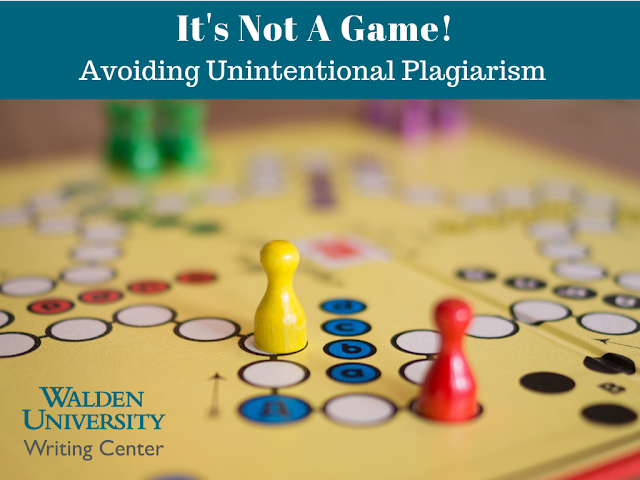It's Not A Game! Avoiding Unintentional Plagiarism
If you’re ever played board games with your family or
friends, maybe you have dealt with someone who cheats at them. Growing up, my
older sister made cheating at board games a science—each time I would catch her
in the act, she would find a new way to cheat next time. These board game
shenanigans meant that playing detective with her cheating was more of the
actual game we were playing. I’m still waiting for the board game police to
show up.
Unlike cheating at board games, though, there are
consequences to academic dishonesty such as plagiarism. Intentional plagiarism is a fairly cut and
dry to understand. When plagiarism occurs, though, it is often unintentional plagiarism.
Unfortunately, that doesn’t mean that it doesn’t carry the same academic
consequences. This isn’t meant to scare you, though, as there are some fairly
easy ways to avoid accidental plagiarism. In this blog post, I want to discuss
two main tips for avoiding plagiarism: correctly citing each sentence that provides
information from a source and correctly paraphrasing points from a source.
Citing Correctly
If you have had a paper review with one of our Walden University Writing Instructors, maybe your instructor
pointed out to you the need to cite each sentence that provides information
from a source, and you wondered, why? For instance, maybe you cited at the end
of a paragraph or cited every other sentence because you were citing the same
source throughout the paragraph. The issue is that each point that comes from a
source is not attributed to a source, so those un-cited sentences suggest to
readers that they are your own ideas when they are actually coming from a
source. Both not attributing ideas to a source and falsely attributing ideas from
a source as your own and are forms of plagiarism.
Correct citation also refers to ensuring direct quotes are properly formatted. For instance, when a direct quote is
included, the page number where the quote was found would be included (as “p.
xx”). For sources with no page numbers, the paragraph number would be included
(as “para. xx”). As well, quote marks
need to be included around the quoted material, otherwise, readers will assume
that the information is a paraphrase. Presenting quoted material as a
paraphrase is a form of plagiarism.
To avoid plagiarism, then, it is important to correctly cite by: 1) ensuring each sentence that provides information from a source
is cited so that information is correctly attributed to the source and not
falsely attributed to you, and 2) ensuring direct quotes are correctly
formatted so the information is not presented as your paraphrase of that
information or point.
Paraphrasing Correctly
Paraphrasing is usually better than quoting since
paraphrasing demonstrates a writer’s command of the material and direct quotes,
especially long ones, can disrupt the flow of points since they are in a
different voice from the author. With this in mind, while incorrectly
presenting a direct quote as a paraphrase is problematic, so is incorrectly
paraphrasing a source. One way a source might be incorrectly paraphrased is
through patchwork paraphrasing which largely means that some of the original source’s wording
is used. For instance, the paraphrase may change a word here and there, or move
around some of the wording of the original source. In this sense, it would be
similar to including a sentence that is a direct quote from a source but
presenting that direct quote as a paraphrase—the original author’s words are
presented as your own. While not as egregious as not citing at all, ineffective paraphrasing can still be considered to be a form of plagiarism.
So, to avoid plagiarism, it is important to paraphrase
effectively. Paraphrasing effectively means that 1) the paraphrase stays true to the original
sources’ meaning, and 2) the paraphrase is in different wording, and has a
different sentence structure, then the original.
I know this seems like a lot of information, but as I noted
in the beginning, the main tips for avoiding plagiarism include correctly
citing each sentence that provides information from a source, or needs to be
supported by a source, and correctly paraphrasing. Plagiarism can be a scary
word, but it doesn’t have to be if you are informed about how to avoid it.
Students can find Walden’s general policy for academic
integrity in the Handbook's Academic Integrity section under Code of Conduct.
While the Writing Center is not involved with any program-specific or overall
university guidance, we do have sources on citing and avoiding plagiarism. For
instance, we have a page on how to cite and how often, a plagiarism prevention checklist, plagiarism prevention modules, and a plagiarism prevention webinar.
Have any questions about avoiding accidental plagiarism?
Have any tips you use to avoid accidental plagiarism? Let us know!
Veronica Oliver is a Writing Instructor in the Walden Writing Center. In her spare time she writes fiction, binge watches Netflix, and occasionally makes it to a 6am Bikram Yoga class.
.png)
Never miss a new post; Opt-out at any time
Subscribe to:
Post Comments
(
Atom
)





No comments :
Post a Comment